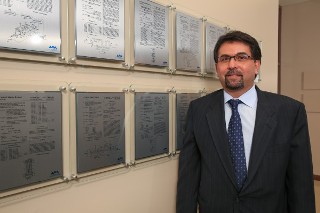Apr 9 2015
Three commercially viable proposals that resulted from research at The University of Alabama in Huntsville (UAH) have been awarded over $43,000 from the Charger Innovation Fund (CIF).
 Kannan Grant is director of the Office of Technology Commercialization (OTC), which administers the Charger Innovation Fund. Credit: Michael Mercier / UAH
Kannan Grant is director of the Office of Technology Commercialization (OTC), which administers the Charger Innovation Fund. Credit: Michael Mercier / UAH
The CIF is funded by the UAH Office of the Vice President for Research and Economic Development (OVPRED) and administered by the Office of Technology Commercialization (OTC).
“The overall goal of this investment is to enhance UAH’s role as an integral part of the economic engine in our community,” says Dr. Ray Vaughn, vice president for research and economic development.
Proposals funded:
- “liquidTrac: A Smartphone-Based Monitoring of Liquid Intake,” Dr. Emil Jovanov, Electrical and Computer Engineering Dept., $14,931 – A smart water bottle monitors the amount of liquid in the bottle and transmits the information to a cell phone. The product is intended to remind people to drink enough water for a healthy lifestyle or, for patients with congestive heart failure or kidney disease, to limit water intake. A physician can access information on water consumption with permission.
- “Bridging Nano-Biosensing Technology to Device Commercialization,” Dr. Yongbin Lin, Center for Applied Optics, $14,725 – A fiber-based nano-biosensor can be used for molecular analysis in point-of-care applications. The goal is to create low-cost, compact, easy-to-use biosensors for early detection of cancer and other diseases in any environment.
- “Robust Ultra-Thin Silicon Film Color Filters for Display Applications,” Dr. Junpeng Guo, Electrical and Computer Engineering Dept., $13,933 – These silicon and metal-based filters rely on optical wave interference to display colors. Unlike current optical filters, they are low cost, robust and do not change color due to changes in angle. They are intended for use in display applications such as television and computer screens, signs and logos.
Seven proposals were heard by a panel of judges from UAH and the business and legal community, who listened as applicants explained each innovation and then quizzed them about its marketability before making their selections.
“The process requires the applicants to think of what kind of problem or problems they are trying to solve with their product,” says Kannan Grant, director of the OTC. “This is the third time we have done this CIF, and the innovation message is becoming clearer. The proposals seem to focus more on innovation and commercialization. For example, some of the winners this year brought with them working and demonstrable product prototypes.”